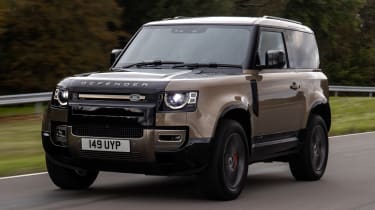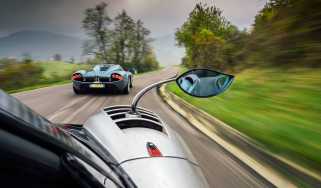Land Rover Defender – engine, gearbox and technical highlights
Ingenuim petrols and diesels make up the core range, with a stonking supercharged V8 topping the tree
Land Rover went about completely changing the Defender’s engine range soon after it launched, ditching all four-cylinder diesels for a set of replacement sixes, and introducing a plug-in hybrid option. These join the existing four- and six-cylinder petrol engines, and all are now mild-hybrid except for the base four-cylinder petrol.
The bulk of UK sales are expected to be made up by the six-pot diesels, which are available in D250 and D300 variants. These generate 246bhp and 296bhp respectively, with peak torque is rated at 420 and 480lb ft and available from as low as 1250rpm.
The P300 four-cylinder petrol is the least suited to the Defender, as it can struggle to move the considerable mass without feeling overwhelmed, and the 297bhp turbo unit suffers from the same issues as seen in other applications, namely its poor calibration to the transmission and general lack of refinement.
The P400 mild-hybrid is a better trade-off if you’re just not interested in a diesel option, with the 3-litre unit featuring both a conventional twin-scroll turbocharger and a 48V electric supercharger. Combined, these two elements help produce 394bhp and 406lb ft of torque. There’s also a belt-integrated starter motor in lieu of an alternator, with a 48V lithium-ion battery that stores recuperated energy as the car slows.
More reviews
In-depth reviews
Long term tests
- Land Rover Defender 90 V8 Fast Fleet test – living with the 5-litre V8 4x4
- Land Rover Defender 110 Fast Fleet test – 9000 miles in the go-anywhere SUV
Reviews
- Land Rover Defender Octa 2025 review – so much more than a ‘Defender SV’
- Land Rover Classic Defender V8 2024 review – driving a £190,000 Land Rover
- Land Rover Defender 130 V8 2024 review – an exercise in excess
- Bowler Defender 2023 review
- Bowler Defender Challenge 2022 review – the ultimate off-road toy?
- Land Rover Defender V8 2021 review – a G63 rival, or something more subtle?
Finally, there's the P400e plug-in hybrid. Although we’re yet to try the system in the new Defender, it's impressively refined and just about powerful enough to overcome the extra weight gain in its other JLR applications. Drive in all models is via an eight-speed ZF automatic gearbox, with twin-speed transmissions providing both high and low ratios, the latter for towing and off-road use.
These different powertrain options are then connected to the most technologically advanced Defender yet. Built on an all-new aluminium monocoque chassis Land Rover calls internally D7x, the new Defender is available as a three-door 90 or five-door 110 and 130 models, as well as a commercial vehicle. The 110 is available with three seating configurations: five, six, or a five + two, with the 90 limited to a maximum of half a dozen seats. The 130, meanwhile, can carry eight. Beneath Gerry McGovern’s design is the full complement of technical kit to take the Defender anywhere it cares to go. There’s a two-speed transfer ’box within the eight-speed auto, centre- and rear-locking differentials and, of course, permanent four-wheel drive.
Independent multi-link double wishbone suspension is fitted at the front, with an integral link axle at the rear, while air suspension is standard across the 110 range, with the X model also featuring as standard an electronic differential, Terrain Response 2, configurable terrain response – think driver modes for sports cars but for a car designed for bog snorkelling rather than lap times – and all-terrain progress control (an off-road cruise control system).





